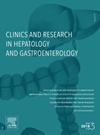氧化应激、脂质代谢紊乱和肠道微生物失调在奥沙利铂诱导的脂肪肝疾病中的参与:来自树鼩模型的证据
IF 2.4
4区 医学
Q2 GASTROENTEROLOGY & HEPATOLOGY
Clinics and research in hepatology and gastroenterology
Pub Date : 2025-07-01
DOI:10.1016/j.clinre.2025.102645
引用次数: 0
摘要
背景:奥沙利铂是结直肠癌的基础治疗药物,但仍有相当比例的患者发生药物性脂肪性肝病(DILI)。它是如何引起这种肝损伤的尚不清楚,肠道微生物群是否参与其中仍不清楚。方法:采用6次腹腔注射(7 mg/kg / 2周)建立奥沙利铂致DILI雄性树鼩模型。在肝损伤的早期和晚期,对肝组织进行组织病理学、氧化应激和转录谱分析,并对粪便进行基于16S rRNA测序的微生物谱分析。结果:该模型重现了DILI的主要特征,包括最终治疗后早期出现严重的肝细胞脂肪变性和肝球囊化,晚期出现轻度肝脂肪变性伴窦状动脉扩张,两期均出现持续的肝脏氧化应激。肝脏组织转录分析鉴定出奥沙利铂治疗动物和对照动物之间有1503个差异表达基因(DEGs),其中601个差异表达基因在DILI最终治疗后的早期或晚期存在差异。途径富集显示氧化应激(如NDUFA12、OSR1、MPO)和脂质代谢(如LDAH、ACACB、CH25H、LIPE)基因明显失调。肠道菌群分析显示,潜在有害细菌(如拟副杆菌、里氏菌、阿里士菌和粪菌)的相对丰度增加,同时抗氧化细菌(如乳球菌和黄杆菌)的丰度减少。值得注意的是,肠道中几种微生物属的丰度与肝脏中参与氧化应激和脂质代谢的基因表达以及氧化应激标志物的水平和/或肝脏中的脂肪沉积有关。结论:我们的研究结果表明,我们的树鼩模型可以忠实地复制奥沙利铂诱导的脂肪性肝病的关键特征,并且这种疾病涉及肝脏的氧化应激和脂质代谢紊乱以及肠道微生物群的失调。本文章由计算机程序翻译,如有差异,请以英文原文为准。
Involvement of oxidative stress, lipid dysmetabolism and gut microbiol dysbiosis in oxaliplatin-induced fatty liver disease: evidence from a tree shrew model
Background
Oxaliplatin is cornerstone treatment for colorectal cancer, yet a significant proportion of patients develop drug-induced fatty liver disease (DILI). How it induces such liver injury is poorly understood and whether the gut microbiome is involved remains unknown.
Methods
A male tree shrew model of oxaliplatin-induced DILI was established by six intraperitoneal injections (7 mg/kg every two weeks). During the early and late phases of liver injury, liver tissue was analyzed in terms of histopathology, oxidative stress and transcriptional profiling, while feces were subjected to microbial profiling based on 16S rRNA sequencing.
Results
The model recapitulated key features of DILI, including severe hepatocyte steatosis and ballooning in the early phase after the final treatment, mild hepatic steatosis with sinusoidal dilatation in the late phase, and persistent hepatic oxidative stress during both phases. Transcriptional analysis of liver tissue identified 1503 differentially expressed genes (DEGs) between oxaliplatin-treated and control animals, of which 601 DEGs differed between treated animals in the early or late phases after the final treatment of DILI. Pathway enrichment revealed significant dysregulation in oxidative stress (e.g. NDUFA12, OSR1, MPO) and lipid metabolism (e.g., LDAH, ACACB, CH25H, LIPE) genes. Gut microbiota profiling showed an increase in the relative abundance of potentially harmful bacteria (e.g., Parabacteroides, Rikenella, Alistipes and Faecalitalea) and a concurrent decrease in the abundance of anti-oxidative bacteria (e.g., Lactococcus and Flavobacterium). Notably, abundance of several microbial genera in the gut correlated with liver expression of genes involved in oxidative stress and lipid metabolism as well as with levels of oxidative stress markers, and/or fat deposition in the liver.
Conclusion
Our results suggest that our tree shrew model can faithfully replicate key characteristics of oxaliplatin-induced fatty liver disease, and that such disease involves oxidative stress and lipid dysmetabolism in the liver as well as dysbiosis of microbiota in the gut.
求助全文
通过发布文献求助,成功后即可免费获取论文全文。
去求助
来源期刊

Clinics and research in hepatology and gastroenterology
GASTROENTEROLOGY & HEPATOLOGY-
CiteScore
4.30
自引率
3.70%
发文量
198
审稿时长
42 days
期刊介绍:
Clinics and Research in Hepatology and Gastroenterology publishes high-quality original research papers in the field of hepatology and gastroenterology. The editors put the accent on rapid communication of new research and clinical developments and so called "hot topic" issues. Following a clear Editorial line, besides original articles and case reports, each issue features editorials, commentaries and reviews. The journal encourages research and discussion between all those involved in the specialty on an international level. All articles are peer reviewed by international experts, the articles in press are online and indexed in the international databases (Current Contents, Pubmed, Scopus, Science Direct).
Clinics and Research in Hepatology and Gastroenterology is a subscription journal (with optional open access), which allows you to publish your research without any cost to you (unless you proactively chose the open access option). Your article will be available to all researchers around the globe whose institution has a subscription to the journal.
 求助内容:
求助内容: 应助结果提醒方式:
应助结果提醒方式:


